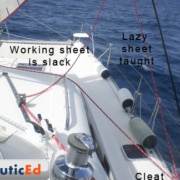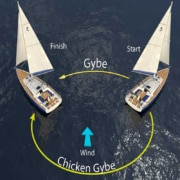Trim the main sail
When learning to sail the main thing we’re excited about doing is getting the boat moving, but as we become more advanced, we really want to understand the different forces on the boat and maximize the efficiency. Proper understanding of sail trim can help us achieve that. This post is a good example of exactly that.
What a wonderful labor day sail we had here last weekend on Lake Travis. The lake is currently 38 ft low in one of Austin’s worst droughts since the 60’s. So the sail started out by me walking out to an island – yes walking, then catching up with some friends who had already sailed their boat over for an island (now peninsular) pig roast.
At about 7pm we hoisted sails and did great westerly down wind run to a point in the lake where it turns south. About 20 minutes after the turn south the wind picked up to 15 knots and put us on a really nice beat for a 2.5 hour sail back to the dock.
We were sailing a Beneteau 373. Traditionally, my friend has had issues with this boat rounding up in higher winds and so we put some of the sailing lessons from Captain Ed Mapes NauticEd Sail Trim Course to work for us.
Rounding up is caused by many factors. One is too much wind and force aloft which tends to heel the boat over. This reduces the amount of rudder in the water and thus the rudder’s effectiveness. Another factor in rounding up is the center of pressure of wind on the sails is too far aft which then pushes the aft of the boat downwind and thus the front of the boat up wind.
What we wanted to do this last weekend was to reduce the aloft pressure from the 15 knot wind.
We must first understand wind shear. The phenomenon of wind shear is pretty easy. Wind moves faster at the top of the mast than is does at the water level because the stationary water slows the wind down which in turn slows the wind down slightly above it etc.
Additionally, if your boat was standing still the wind at the top of the mast would be the same apparent direction as at the cockpit level. However as your boat picks up in speed the wind at the top appears to come from further aft. This is also easily understood by imagining driving your car in a cross wind with your hand out the window of the car. The faster you go, the more the apparent wind moves towards coming from the front. But when a gust of wind comes from the side then the apparent wind shifts back to the side. In a boat, since the wind at the top is faster than the wind at the bottom, as the boat picks up in speed then the top wind appears to come from further aft.
This is now quite a revelation! It means that the top of the main needs to be “out” further than the bottom of the sail for it to operate efficiently.

The top of the mainsail needs to go further out so that the starboard telltale can fly smoothly
In the illustration, you can see the top telltale on the downwind side is fluttering. If you let out the main at the top the wind can reattached to the sail on the down wind side and the telltale will fly smoothly.
The way that you can let out the top of the main is to let out the main sheet. However the consequence of this is that the bottom also goes out. To bring the bottom back in again, use the traveler by bringing it up to windward.
This can also be continued to “twist out” the sail in higher wind speeds at the top to de-power the top of the sail which thus reduces the force at the top and decreases heel angle of the boat. At this point you’re using mostly the bottom part of the main sail which has less heeling moment.
So the sailing lesson here is when in higher winds bring the traveler up and sheet out the main. You’ll also need to release the boom vang a little. If the boom vang is down tight, the effect of sheeting out the main will be reduced. Letting the boom vang out allows the boom to rise which loosens the leech (trailing edge) of the sail and allows the top part to “twist out”.
All in all, our 15 knot labor day sail in the night back to the dock was a successful learning event for the boat owner and confirmation that the NauticEd SailTrim course is very much worth the $39 investment.







